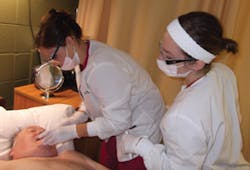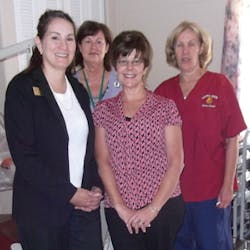Ferris State dental hygiene students care for senior patients
FERRIS STATE PROGRAM TARGETS NURSING HOME RESIDENTS
BY CATHERINE W.J. ARCHER, RDH, BS, MS
Mixed emotions run through your mind as you read the familiar name on your schedule for the upcoming week: “Jane Doe: pro, no X-rays.” This particular patient is elderly, in her late eighties, and she has most of her own teeth, with some fixed bridge work. You remember that she takes a variety of prescription meds, that she has dry mouth, noteworthy arthritis, and that she accumulates calculus quickly. You also recall that she cannot sit back in the dental chair very far, and her visits always take more time than what is scheduled.
A couple of days after you initially saw the patient’s name on your schedule, you notice it is gone. When you ask the office manager about it, she tells you that, upon a reminder call, she was told that the patient is now residing at a nursing home and is unable to keep her cleaning appointment.
Again, you have mixed emotions. How can her dental care be continued? Jane Doe still needs to have her teeth cleaned!
This situation is becoming more of a reality. The baby boomers are aging. According to the report “A Profile of Older Americans: 2010” by the U.S. Department of Health and Human Services, the percentage of Americans who are 65 and older has more than tripled since 1900. What’s even more astounding is that the numbers are greater in the older age groups. The 75- to 84-year-old age group was 17 times the size it was in 1900, and the 85 and older age group was 46 times the size it was in 1900. Americans are living longer as documented in the 2010 report. As of 2007, those reaching the age of 65 were usually living to see another 18.6 years of life. The death rates of the 65- to 84-year-old age group have seen a reduction. With baby boomers increasing in age, there will be a higher demand for long-term care facilities.2 There was a 15% increase in the population of those 65 and older between 2000 and 2010, and between 2010 and 2020, it will increase by 36%.1
There are many challenges regarding our aging population since they are keeping their teeth longer. For one, only 22% of the elderly are covered by private dental insurance. According to the Centers for Disease Control and Prevention, “Oral diseases and conditions are common among these Americans who grew up without the benefit of community water fluoridation and other fluoride products.” Add lacking insurance, being poor, a minority, disabled, homebound, or institutionalized, and your risk of poor oral health increases, according to the same source. They also published a report in March 2001 titled “The Oral Health of Older Americans,” which states that it is more difficult to finance dental care for the elderly because there are no federal or state programs to cover routine dental services.7
One Solution
Sandra G. Burns, RDH, RDA, RN, MS, professor of community dentistry at Ferris State University, saw this need as an educational project to address with the Ferris State Dental Hygiene program. A grant was written requesting “engagement of dental hygiene students in clinical enrichment experiences by providing oral health care to patients of diverse populations (…geriatric patients, medically compromised and patients in long-term health care facilities…) in the greater Big Rapids community.”3 A partnership was created with one of the local facilities, which is a one-hundred bed nursing home, of which the majority of the residents are elderly. The facility provided a room for use and it was set up with a Ferris State University dental unit, which was installed in a private examination room as mandated by senate bill No. 747.6 Supplies were available because of the grant funding.
The dates of this initial project ran from June 2011 through May 2012. The budget of $7,175 included $300 for supplies and materials and $6,875 for equipment (including battery-operated slow-speed handpieces, a mobile air/water evacuation unit, and a handheld portable digital dental X-ray unit). Beginning in August of 2011, FSU dental hygiene faculty and a clinic dentist visited to perform initial oral screenings, thus identifying underserved residents who could benefit from oral health screenings and prophylaxis, fluoride varnish, tooth brushing and denture cleanings. This was done ahead of time so when students began their clinical rotations in the fall 2011 semester, they were able to begin patient treatment immediately. In September 2011, under the supervision of FSU dental hygiene faculty, second year dental hygiene students began their two-semester community dentistry clinical rotations. A total of 42 dental hygiene students rotated into the facility, at two to four visits each, per semester. These rotations served as academic service learning, community dentistry, and outreach learning experiences for the dental hygiene students. Ranging from oral exams to full-mouth prophylaxes, a total of 147 services were provided in the fall semester, and a total of 116 services were provided in the spring semester.
Student Feedback
The FSU Dental Hygiene class of 2012 was exposed to multiple situations regarding providing patient care with dignity. After the students spent time on task, they completed a written assignment, recording what services they had provided and their personal thoughts about the day’s encounters. Many students had no prior experience working with the elderly. The few who did have geriatric experience were very industrious and confident in what they could do for their patients. Many of the students were amazed by the poor oral hygiene and massive amounts of materia alba that they saw on the majority of residents’ teeth or dentures. Most of the students were very thankful for the opportunity to rotate into the facility to offer dental hygiene services. Several groups of students created and presented poster table clinics at various dental hygiene activities regarding their experiences in the facility. Plans for the future are to continue offering dental hygiene services to the residents of this facility via the second-year dental hygiene students during their fall and spring semester community dental/clinical rotations. RDH
References
1. A Profile of Older Americans, 2010. Department of Health and Human Services, USA. http://www.aoa.gov/AoARoot/Aging_Statistics/Profile/2010/docs/2010profile.pdf
2. Altani A, Wyatt CCL, Probe (08341494), 2002. May-June; 36 (3): 91-2, 93-6, “Oral Hygiene and Institutionalized Elders.” Retrieved from http://www.cdha.ca/pdfs/Education/Scene/volume36_3_page14.pdf
3. Beistle, K. 2010. Exceptional Merit Grant Program for Faculty and Staff. Retrieved from Ferris State University.
4. Oral Health for Older Americans, 2006. Centers for Disease Control. http://www.cdc.gov/OralHealth/publications/factsheets/adult_older.htm
5. Crozier, S. Experts Eye Oral Health of Older Adults. 2010. ADA. Retrieved from http://www.ada.org/news/3975.aspx
6. Senate Bill No. 747, 2011. Retrieved from http://www.legislature.mi.gov/S(y1r3tk55lwnobs45dgkixl55))/mileg.aspx?page=getobject&objectname=2011-SB-0747
7. Vargas CM, Kramarow EA, Yellowitz JA. 2001. The Oral Health of Older Americans (PDF–285K) Aging Trends, No. 3. Hyattsville, MD: National Center for Health Statistics. Retrieved from http://www.cdc.gov/nchs/data/ahcd/agingtrends/03oral.pdf
CATHERINE W.J. ARCHER, RDH, BS, MS, received the “Outstanding Clinician Award” from Ferris State University, where she graduated in 1987. She returned to school and received her bachelor’s in allied health education in 2006 and her master’s in career tech education/instructor option in 2008. She is currently an assistant professor in the Ferris State University dental hygiene program. Some courses she instructs are head and neck oral sciences, oral pathology, periodontics, clinical hygiene, and dental hygiene role transitions, an online course in the RDH BS program..
Past RDH Issues


